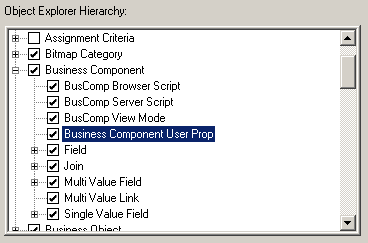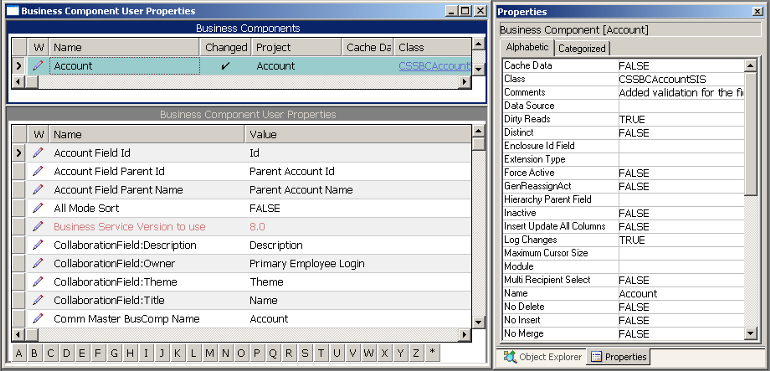Understanding user properties
User properties are child object types which are available for the following object types in the Siebel Repository:
- Applet, Control, List Column
- Application
- Business Service
- Business Component, Field
- Integration Object, Integration Component, Integration Component Field
- View
To view the User Property (or User Prop as it is sometimes abbreviated) object type we typically have to modify the list of displayed types for the Object Explorer window. This can be achieved by selecting the Options command in the View menu. In the Object Explorer tab of the Development Tools Options dialog, we can select the object types for display as shown in the following screenshot:

In the preceding example, the Business Component User Prop type is enabled for display.
After confirming the changes in the Development Tools Options dialog by clicking the OK button, we can for example navigate to the Account business component and review its existing user properties by selecting the Business Component User Prop type in the Object Explorer.
The following screenshot shows the list of user properties for the Account business component:

Unlock access to the largest independent learning library in Tech for FREE!
Get unlimited access to 7500+ expert-authored eBooks and video courses covering every tech area you can think of.
Renews at $19.99/month. Cancel anytime
The screenshot also shows the standard Properties window on the right. This is to illustrate that a list of user properties, which mainly define a Name/Value pair, can be simply understood as an extension to an object type's usual properties which are accessible by means of the Properties window and represent Name/Value pairs as well.Because an additional user property is just a new record in the Siebel Repository, the list of user properties for a given parent record is theoretically infinite. This allows developers to define a rich set of business logic as a simple list of Name/Value pairs instead of having to write program code.The Name property of a user property definition must use a reserved name - and optional sequence number - as defined by Oracle engineering. The Value property must also follow the syntax defined for the special purpose of the user property.
Because an additional user property is just a new record in the Siebel Repository, the list of user properties for a given parent record is theoretically infinite. This allows developers to define a rich set of business logic as a simple list of Name/Value pairs instead of having to write program code.
The Name property of a user property definition must use a reserved name—and optional sequence number—as defined by Oracle engineering. The Value property must also follow the syntax defined for the special purpose of the user property.
Did you know?
The list of available names for a user property depends on the object type (for example Business Component) and the C++ class associated with the object definition. For example, the business component Account is associated with the CSSBCAccountSIS class which defines a different range of available user property names than other classes.
Many user property names are officially documented in the Siebel Developer's Reference guide in the Siebel Bookshelf. We can find the guide online at the following URL:
http://download.oracle.com/docs/cd/E14004_01/books/ToolsDevRef/ToolsDevRef_UserProps.html
The user property names described in this guide are intended for use by custom developers. Any other user property which we may find in the Siebel Repository but which is not officially documented should be considered an internal user property of Oracle engineering. Because the internal user properties could change in a future version of Siebel CRM in both syntax and behavior without prior notice, it is highly recommended to use only user properties which are documented by Oracle.
Another way to find out which user property names are made available by Oracle to customers is to click the dropdown icon in the Name property of a user property record. This opens the user property pick list which displays a wide range of officially documented user properties along with a description text.
Multi-instance user properties
Some user properties can be instantiated more than once. If this is the case a sequence number is used to generate a distinguished name. For example, the On Field Update Set user property used on business components uses a naming convention as displayed in the following screenshot:

In the previous example, we can see four instances of the On Field Update Set user property distinguished by a sequential numeric suffix (1 to 4).
Because it is very likely that Oracle engineers and custom developers add additional instances of the same user property while working on the next release, Oracle provides a customer allowance gap of nine instances for the next sequence number. In the previous example, a custom developer could continue the set of On Field Update Set user properties with a suffix of 13. By doing so, the custom developer will most likely avoid conflicts during an upgrade to a newer version of Siebel CRM. The Oracle engineer would continue with a suffix of five and upgrade conflicts will only occur when Oracle defines more than eight additional instances. The gap of nine also ensures that the sequence of multi-instance user properties is still functional when one or more of the user property records are marked as inactive.
In the following sections, we will describe the most important user properties for the business and user interface layer. In addition, we will examine case study scenarios to identify best practices for using user properties to define specialized behavior of Siebel CRM applications.
Business component and field user properties
On the business layer of the Siebel Repository, user properties are widely used to control specialized behavior of business components and fields. The following table describes the most important user properties on the business component level. The Multiple Instances column contains Yes for all user properties which can be instantiated more than once per parent object:

Source: Siebel Developer's Reference, Version 8.1:
http://download.oracle.com/docs/cd/E14004_01/books/ToolsDevRef/booktitle.html
 United States
United States
 Great Britain
Great Britain
 India
India
 Germany
Germany
 France
France
 Canada
Canada
 Russia
Russia
 Spain
Spain
 Brazil
Brazil
 Australia
Australia
 Singapore
Singapore
 Canary Islands
Canary Islands
 Hungary
Hungary
 Ukraine
Ukraine
 Luxembourg
Luxembourg
 Estonia
Estonia
 Lithuania
Lithuania
 South Korea
South Korea
 Turkey
Turkey
 Switzerland
Switzerland
 Colombia
Colombia
 Taiwan
Taiwan
 Chile
Chile
 Norway
Norway
 Ecuador
Ecuador
 Indonesia
Indonesia
 New Zealand
New Zealand
 Cyprus
Cyprus
 Denmark
Denmark
 Finland
Finland
 Poland
Poland
 Malta
Malta
 Czechia
Czechia
 Austria
Austria
 Sweden
Sweden
 Italy
Italy
 Egypt
Egypt
 Belgium
Belgium
 Portugal
Portugal
 Slovenia
Slovenia
 Ireland
Ireland
 Romania
Romania
 Greece
Greece
 Argentina
Argentina
 Netherlands
Netherlands
 Bulgaria
Bulgaria
 Latvia
Latvia
 South Africa
South Africa
 Malaysia
Malaysia
 Japan
Japan
 Slovakia
Slovakia
 Philippines
Philippines
 Mexico
Mexico
 Thailand
Thailand


















